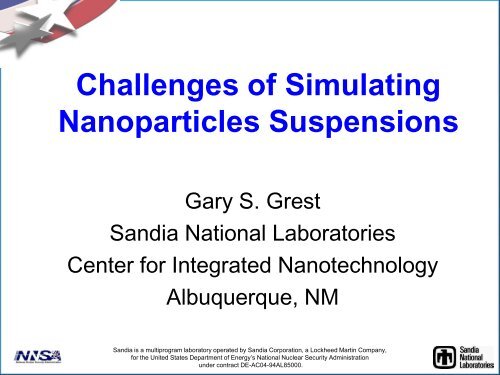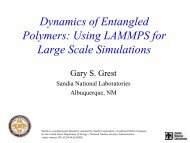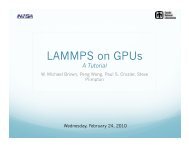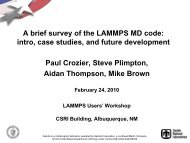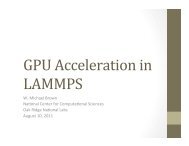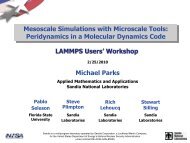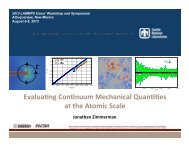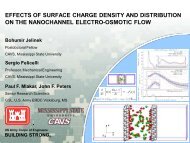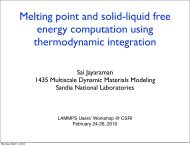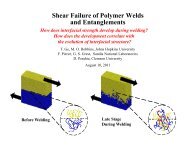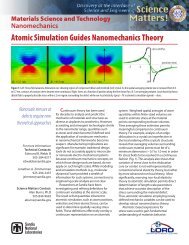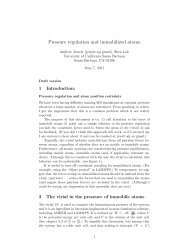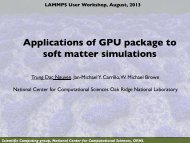Challenges of Simulating Nanoparticles Suspensions - Lammps
Challenges of Simulating Nanoparticles Suspensions - Lammps
Challenges of Simulating Nanoparticles Suspensions - Lammps
Create successful ePaper yourself
Turn your PDF publications into a flip-book with our unique Google optimized e-Paper software.
<strong>Challenges</strong> <strong>of</strong> <strong>Simulating</strong><br />
<strong>Nanoparticles</strong> <strong>Suspensions</strong><br />
Gary S. Grest<br />
Sandia National Laboratories<br />
Center for Integrated Nanotechnology<br />
Albuquerque, NM<br />
Sandia is a multiprogram laboratory operated by Sandia Corporation, a Lockheed Martin Company,<br />
for the United States Department <strong>of</strong> Energy’s National Nuclear Security Administration<br />
under contract DE-AC04-94AL85000.
Polymer Nanoparticle Complexes<br />
Controlled Designed Properties<br />
• Mechanical, Thermal<br />
• Optical<br />
• Electronic<br />
• Transport<br />
High performance materials<br />
Plasmonic devices<br />
Sustainable energy<br />
Protein Recognition<br />
Drug and Gene Carriers<br />
Polymer-mediated assembly <strong>of</strong> Au NP<br />
Y. Ofir, B. Samanta and V. M. Rotello,<br />
Chem. Soc. Rev. 37, 1814 (2008)
Nanoparticle Assembly <strong>Challenges</strong><br />
• Synthesis <strong>of</strong> nanoparticles<br />
well defined size,<br />
uniform, stable coating<br />
• Tailored properties<br />
optical, electrical, and<br />
magnetic<br />
Slow evaporation <strong>of</strong> solvent<br />
•Assemble nanoparticles<br />
retaining unique<br />
properties without<br />
acting like a bulk metal<br />
-long range order is possible, only some<br />
times desirable, but <strong>of</strong>ten not necessary<br />
Bigioni et al, Nature Mat.5, 265 (2006)
Organic Coated <strong>Nanoparticles</strong><br />
PEO (6)<br />
Polyethylene PEO(6) coated<br />
5nm silica nanoparticle in<br />
water (3.1 chains/nm 2 )<br />
PEO(100)<br />
0.5 chains/nm 2<br />
Aspherical Shape<br />
Lane et al, PRE 79, 050501 (2009); in<br />
prep (2011)
Molecular Dynamics Simulations<br />
• 4x10 5 – 7.2x10 7 atoms<br />
• van der Waal, bond, bending, torsional interactions<br />
-ab inito quantum chemistry based<br />
• Time step 1fs - runs 5 -100ns<br />
• OPLS force fields<br />
• TIP4P H 2 O (fix shake for bonds/angles)<br />
• Systems<br />
– PEO coated Silica in H 2 O<br />
– Alkanethiol Au in H 2 O and decane<br />
C)<br />
PEO (6)<br />
• LAMMPS Commands<br />
–Nanoparticle core rigid (fix rigid/nve)<br />
–Equilibrate Solvent – make hole (fix indent sphere)<br />
–rRESPA (run_style respa)
Toys for the Simulator<br />
4 cores<br />
800<br />
Megaflops<br />
8400 processors<br />
New Mexico Computer<br />
Red Sky<br />
Applications Center<br />
Hopper –<br />
Cray XE6<br />
Cray ~ 1985<br />
153,408 cores<br />
1.3 Peraflops<br />
C<br />
18544 cores<br />
217 TeraflopsIntel 2005-<br />
2010<br />
Jaguar– Cray XT 5<br />
224,000 cores<br />
2.3 Petaflops
LAMMPS Benchmarks<br />
L<br />
• Strong scaling for a 5.3 million<br />
all-atom simulation <strong>of</strong> 8<br />
nanoparticles in water<br />
• run_style respa –k-space every<br />
4 th step<br />
– Improved efficiency<br />
– 30-40% speedup over<br />
run_style verlet<br />
• Sweet spot ~ 512-2048 cores<br />
• More than 4096 cores scaling<br />
becomes very inefficient<br />
– XT5 – wall clock increases<br />
with increasing number <strong>of</strong><br />
cores<br />
• Scientific output limited - 0.5-0.7ns/day on 2048 cores<br />
with present implementation <strong>of</strong> PPPM<br />
- 1D FFT’s limit total number <strong>of</strong> cores
Interactions between <strong>Nanoparticles</strong><br />
• Determine velocity independent (solvation)<br />
and velocity dependent (lubrication) forces<br />
-chain length, nanoparticle size/shape, coverage<br />
• Integrate into coarse-grained model<br />
Lane et al, Phys. Rev. E 79, 050501(R) (2009); Ismail, Lane, Grest, in prep.
Force between Silica <strong>Nanoparticles</strong><br />
• Stokes drag at large<br />
separation with linear<br />
velocity scaling<br />
• Complex mixed<br />
response in the<br />
separation range <strong>of</strong><br />
interest (near contact)<br />
• No oscillations in force<br />
26x26x46 nm 3<br />
50 m/s approach<br />
5 m/s approach<br />
Equilibrated with fit<br />
5 nm PEO(6) coated silica NP – 3 chains/nm 2
Interactions between <strong>Nanoparticles</strong><br />
• 300K, thermal fluctuations corresponds to<br />
forces < 1 nN
Alkanethiol Coated Au <strong>Nanoparticles</strong> in Water<br />
Symmetric Coating Leads to Asymmetric Shapes<br />
8 nm 4 nm 2 nm diameter<br />
C10-CH 3<br />
C10-COOH<br />
C18-CH 3<br />
C18-COOH<br />
Lane, Grest, Phys. Rev. Lett. 104, 235501(2010)<br />
• Geometry is<br />
controlling parameter<br />
•Symmetry Changes<br />
Change assembly<br />
• Small changes<br />
affect structure<br />
change potential<br />
activity
Different Solvents<br />
decane<br />
C18-COOH<br />
C18-CH 3<br />
• CH 3 terminated chains<br />
behave largely as expected to<br />
solvent changes based on<br />
hydrophilic/phobic interactions<br />
Implicit<br />
poor<br />
• COOH terminated chains<br />
form small tight bundles<br />
unless solvated<br />
water<br />
• Implicit solvent captures,<br />
some but not all features <strong>of</strong><br />
explicit solvent
Effect <strong>of</strong> pH – Amine End Groups<br />
C18-NH 3<br />
+<br />
+ Cl -<br />
Neutral pH<br />
C18-NH 2<br />
High pH<br />
•High pH the nanoparticle is insoluble as NH 2 end group<br />
aggregate as found for COOH<br />
• Neutral pH the ligand are dispersed – suggesting nanoparticle<br />
maybe soluble
Coated <strong>Nanoparticles</strong> at a Water/Vapor<br />
Interface<br />
C10 - CH 3 C10 -COOH C18 - CH 3 C18 - COOH<br />
2 nm<br />
diameter<br />
4 nm<br />
diameter<br />
8 nm<br />
diameter
Surface Aggregation and Self-Assembly<br />
Wwater<br />
Water (not<br />
shown)<br />
COOH terminal group<br />
(top)<br />
CH 3 terminal group<br />
(bottom)
Surface Aggregation and Self-Assembly<br />
COOH terminal group<br />
CH 3 terminal group<br />
1,200,000 atoms, ~ 1.1 ns/day on 1152 cores (Red Sky)<br />
~ 2.2 million core hours for 90 ns
Surface Aggregation and Self-Assembly<br />
COOH terminal group<br />
90 ns<br />
CH 3 terminal group<br />
0.8 ns/day on 1920 cores Cray XE6 (Hopper), 1.1 ns/day on 1152 cores Red Sky
Surface Aggregation and Self-Assembly<br />
COOH terminal group<br />
45 ns<br />
CH 3 terminal group
Summary and Conclusions<br />
• For small particles asymmetric coatings are the norm<br />
even for perfectly uniform grafting at full coverage<br />
–Geometric properties dictate when a coatings’ spherical<br />
symmetry will be unstable<br />
– Chain end group and the solvent play a secondary role in<br />
determining the properties <strong>of</strong> surface patterns<br />
• Water/vapor interface significantly distorts and orients the<br />
particle coatings<br />
• Asymmetric and oriented coatings are expected to have<br />
dramatic effects on the interactions between NPs and<br />
strongly influence self-assembly at surfaces
Collaborators:<br />
Acknowledgements<br />
− J. Matthew Lane, Michael Chandross, Steve<br />
Plimpton, Mark Stevens (Sandia National<br />
Laboratories)<br />
− Ahmed Ismail (Universität Aachen)<br />
− Christian Lorenz (King’s College)<br />
Funding:<br />
–Center for Integrated Nanotechnology (CINT)<br />
–DOE – ALCC grant 40 million core hours on NERSC/ORNL<br />
Computers:<br />
– New Mexico Computing Applications Center<br />
– Sandia’s Red Sky<br />
– NERSC Hopper XE 6<br />
– ORNL Jaguar Cray XT 5
Alkanethiol Au <strong>Nanoparticles</strong> in Solution<br />
From a Single Particle to a System:<br />
32 coated<br />
nano particles in<br />
decane (not shown)<br />
100 ns – 40 days on 512 processors


